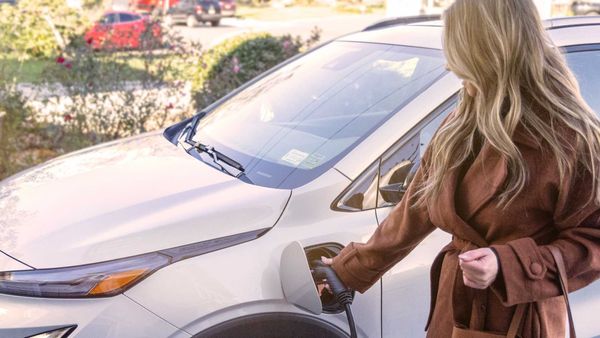
The InsideEVs team knows what it’s like to make the transition from conventional vehicles to EVs. But, if you’ve never driven an EV, don’t panic! It’s almost exactly like what you’re used to. But get ready for some surprises. Good ones.
Starting Out
The differences between traditional vehicles and EVs are noticeable right away.
You’re used to getting in your vehicle, buckling your safety belt, and hitting the start button, or turning a key if you’re old school. That familiar sound of an engine coming to life is the audible confirmation that you’re ready to drive.
In a Battery Electric Vehicle (BEV), that sound and corresponding physical vibration is gone. Absent. There is no engine to start, so when you press start, the vehicle is ready to drive. If you look at the instrumentation closely, you’ll typically find a “ready” icon (or something similar) telling you so.
FYI: If you’re driving a Plugin Hybrid Electric Vehicle (PHEV), depending on your vehicle’s state of charge and ambient temperature (among other factors), the engine may or may not start when you press the start button. This is perfectly normal.
(For a quick primer on electric vehicle terminology, check out our Learning to Speak EV.)

Quietness On The Road
Just as they’re quieter while starting, EVs are quieter and smoother on the road.
EV propulsion systems generally don’t use multi-gear transmissions, and as noted there’s no traditional engine. Therefore, there’s no familiar “rev, shift, rev, shift…” sequence when you’re accelerating from a stop. EV’s deliver an eerily quiet, smooth, and uninterrupted flow of power.
While you won’t hear engine noises at low speeds you will hear a created sound that’s broadcast from the nose of the car. Designed to alert pedestrians of a quiet EV approaching, the NHTSA-required sound turns off once you’ve reached neighborhood velocities. Every brand has its own sound, so a Porsche Taycan doesn’t sound like a Kia Niro, etc.
Power Delivery
EVs absolutely feel different as they accelerate. They deliver an immediate punch from the moment you press the accelerator. There’s no waiting for the engine to rev up, or for the transmission to shift down.
Most drivers find today’s modern EVs very quick, and test results support these feelings. The sub-$30,000 2023 Chevrolet Bolt accelerates from 0-60 mph in about 6.4 seconds. That’s faster than most muscle cars from the 1960s and 70s.
More expensive EVs are considerably faster than the Bolt. The Tesla Model S Plaid can bolt (sorry) to 60 mph in under two seconds!
Regenerative Braking
Unlike conventionally powered vehicles, EVs have two distinct braking methods. There’s the traditional system that utilizes physical brakes (usually discs) at each wheel, plus the significant braking power from the EV’s motor(s). And this is amazing!
When an EV’s motor slows the vehicle, it’s because the motor becomes a generator that converts the vehicle’s speed (kinetic) energy back into electricity that is stored in the vehicle’s battery array, resulting in extended driving range.
Regen braking also extends the life brake pads and rotors. For example, it’s not unusual for EV owners to drive 80,000 miles before brake maintenance is required.

Adjustable Driving Modes
Regen braking enables different driving modes that go beyond the typical normal and sport. While you can drive an EV exactly like a traditional vehicle – use the accelerator to go and the brakes to stop – EVs also offer what’s called one-pedal driving. In other words, a driver can accelerate and stop the vehicle using just the “gas” pedal!
Accelerating works just as you’d expect; press the pedal and go.
But with one-pedal driving, as soon as you reduce the amount of pressure on the accelerator, the vehicle slows. If you lift all the way off the pedal, the EV will generally maximize the amount of regenerative braking (to maximize the battery recharging) and will bring the vehicle to a complete stop. And yes, the brake lights automatically illuminate just as if the brake pedal were pressed.
Importantly, the physical braking system remains active, so when you need more stopping power than one-pedal driving delivers, the physical brake system is ready and waiting.
One-pedal driving might feel counterintuitive when you first try it, but drivers quickly acclimate.
Maximizing Your Drives
Like traditional vehicles, EVs travel farther (have more range) when driven moderately. Jack-rabbit starts and heavy braking decrease range considerably.
But unlike conventionally powered vehicles, EVs are typically more efficient in slower city driving, and less efficient at faster highway speeds.
Temperature extremes also affect EV range, although today’s more advanced EVs are less impacted by this than earlier models.
Do keep in mind that cold and hot temperatures require EVs to divert energy to keep battery packs in the optimal operational temperature range. Heating the cabin in below-freezing temps, and cooling the interior when it’s 90 degrees or hotter also sucks miles from the battery pack. That’s why it's often worth opting for heated seats and steering wheels; heating passengers directly (conductively) is far more energy efficient than heating the cabin air to heat the passengers.
The good news is that even today’s most basic EVs have a range of 240+ miles. Lack of range – or range anxiety for daily driving and commuting – isn’t a problem that today’s EV drivers often encounter.
Getting Out There
In our story titled Charging and Battery Basics, we provided a primer on charging your EV at home. But you won’t always charge at home.
It’s reassuring to know that the U.S. Department of Transportation estimates that there are over 44,000 public chargers available across the country to charge your EV. Most built-in NAV systems include charging stations in their POIs (Points of Interest).
Most EVs can draw a significant range - like from 10 to 80 percent battery charge – in just 30 minutes at public DC Fast Charge stations. Rapid charging technology continues to advance, and charging times are decreasing year after year.










